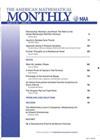二次主理想域的因子环结构
IF 0.4
4区 数学
Q4 MATHEMATICS
引用次数: 0
摘要
摘要前人对高斯整数和爱森斯坦整数的可能因子环进行了分类。这里,我们将这种分类推广到任何二次元域的整数环,只要这个环具有唯一分解。在虚二次域的情况下,分类与高斯整数和爱森斯坦整数的分类具有完全相同的风格。对于真正的二次域,分类只是稍微复杂一点。我们感谢匿名审稿人的反馈,他们的反馈大大改进了本文的阐述。我们也感谢编辑们在校对这篇文章时的敏锐眼光和他们在审查过程中的帮助。作者简介john Greene于1983年获得明尼苏达大学博士学位。他是明尼苏达大学德卢斯分校的数学教授,在那里他已经工作了30多年。他的研究兴趣包括特殊函数、组合学和(初级)计算数论。数学和统计,明尼苏达州德卢斯大学德卢斯,MN 55812 jgreene@d.umn.eduweizhi JingWeizhi Jing获得数学学士学位之间的联合学位项目的一部分明尼苏达大学德卢斯和山西大学在2019年和2021年获得硕士学位UMD。他致力于数学教育,希望攻读环理论或代数数论的博士学位。明尼苏达大学德卢斯分校数学与统计系,德卢斯,明尼苏达州55812jing0049@d.umn.edu本文章由计算机程序翻译,如有差异,请以英文原文为准。
The Factor Ring Structure of Quadratic Principal Ideal Domains
AbstractPrevious authors have classified the possible factor rings of the Gaussian integers and the Eisenstein integers. Here, we extend this classification to the ring of integers of any quadratic number field, provided the ring has unique factorization. In the case of imaginary quadratic fields, the classification has exactly the same flavor as that of the Gaussian integers and Eisenstein integers. For real quadratic fields, the classification is only slightly more complicated.MSC: 11R1113F10 AcknowledgmentWe thank the anonymous referees for feedback which considerably improved the exposition of this article. We also thank the editors for their sharp eyes in proofing this article and for their help during the review process.Additional informationNotes on contributorsJohn GreeneJohn Greene received his Ph.D. from the University of Minnesota in 1983. He is a professor of mathematics at the University of Minnesota Duluth, where he has been for 30+ years. His research interests include special functions, combinatorics and (elementary) computational number theory.Department of Mathematics and Statistics, University of Minnesota Duluth, Duluth, MN 55812jgreene@d.umn.eduWeizhi JingWeizhi Jing received his B.S. in mathematics as part of a joint degree program between the University of Minnesota Duluth and Shanxi University of China in 2019 and received his Master’s degree from UMD in 2021. He is dedicated to mathematical education and hopes to pursue a Ph.D. in ring theory or algebraic number theory.Department of Mathematics and Statistics, University of Minnesota Duluth, Duluth, MN 55812jing0049@d.umn.edu
求助全文
通过发布文献求助,成功后即可免费获取论文全文。
去求助
来源期刊

American Mathematical Monthly
Mathematics-General Mathematics
CiteScore
0.80
自引率
20.00%
发文量
127
审稿时长
6-12 weeks
期刊介绍:
The Monthly''s readers expect a high standard of exposition; they look for articles that inform, stimulate, challenge, enlighten, and even entertain. Monthly articles are meant to be read, enjoyed, and discussed, rather than just archived. Articles may be expositions of old or new results, historical or biographical essays, speculations or definitive treatments, broad developments, or explorations of a single application. Novelty and generality are far less important than clarity of exposition and broad appeal. Appropriate figures, diagrams, and photographs are encouraged.
Notes are short, sharply focused, and possibly informal. They are often gems that provide a new proof of an old theorem, a novel presentation of a familiar theme, or a lively discussion of a single issue.
Abstracts for articles or notes should entice the prospective reader into exploring the subject of the paper and should make it clear to the reader why this paper is interesting and important. The abstract should highlight the concepts of the paper rather than summarize the mechanics. The abstract is the first impression of the paper, not a technical summary of the paper. Excessive use of notation is discouraged as it can limit the interest of the broad readership of the MAA, and can limit search-ability of the article.
 求助内容:
求助内容: 应助结果提醒方式:
应助结果提醒方式:


